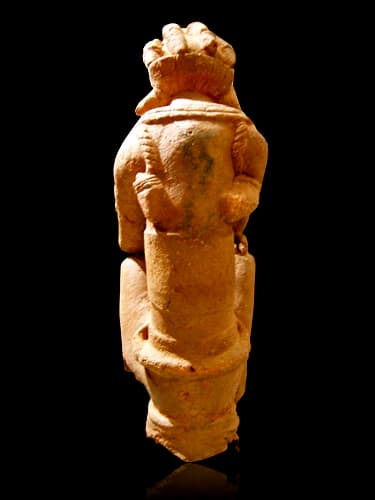Nok Sculpture of a Seated Man, 100 BCE - 300 CE
Terracotta
height 73 cm
height 28 3/4 in
height 28 3/4 in
PF.6200
Some of the earliest examples of sophisticated sculpture in sub-Saharan Africa come from the Nok culture, an Iron Age civilization that has been dated between 900 B.C. and 200 A.D....
Some of the earliest examples of sophisticated sculpture in sub-Saharan Africa come from the Nok culture, an Iron Age civilization that has been dated between 900 B.C. and 200 A.D. The terracotta sculptures range in size from small pendants to life-size figures. We do not know what the people called themselves, so the civilization was named after the small tin-mining village of Nok where the first objects were discovered in 1928. Archaeological artifacts have been found in throughout Nigeria, primarily to the north of the Niger-Benue River confluence and below the Jos escarpment detailing the extent of their cultural influence. According to some accounts, based on artistic similarities between early Yoruba art forms and Nok forms, there may be connections between Nok culture and contemporary Yoruba peoples. What is clear is that certain stylistic tendencies prevalent in black African art today may have originated in the sculptures of the Nok.
This large figure, with his pensive posture and distinctive elongated face, is characteristic of a sub-style of Nok statuary known by the name of Katsina Ala, after the site where such sculptures were first unearthed. The figure features refined molding that Nok sculptures have become famous for. He sits on a columnar post typical of Nok art with his arms folded over his knees. He rests his chin upon his arm and his little beard drapes over. He appears to wear an unusual headdress composed of numerous coiled protrusions. However, it is possible that these protrusions are braids of hair and the headdress is open on top, much like a visor. The man is weighed down in thick strands of beaded necklaces, representing real life counterparts made in stone or metal. He wears several bracelets and anklets as well as a skirt and protective penis sheath. This coiffure and jewelry are reflective of his wealth and elite position within the social structure of his tribe. This style of sculpture is a classic of Nok art, appreciated both for its ancient history as well as its astounding artistry.
This large figure, with his pensive posture and distinctive elongated face, is characteristic of a sub-style of Nok statuary known by the name of Katsina Ala, after the site where such sculptures were first unearthed. The figure features refined molding that Nok sculptures have become famous for. He sits on a columnar post typical of Nok art with his arms folded over his knees. He rests his chin upon his arm and his little beard drapes over. He appears to wear an unusual headdress composed of numerous coiled protrusions. However, it is possible that these protrusions are braids of hair and the headdress is open on top, much like a visor. The man is weighed down in thick strands of beaded necklaces, representing real life counterparts made in stone or metal. He wears several bracelets and anklets as well as a skirt and protective penis sheath. This coiffure and jewelry are reflective of his wealth and elite position within the social structure of his tribe. This style of sculpture is a classic of Nok art, appreciated both for its ancient history as well as its astounding artistry.
